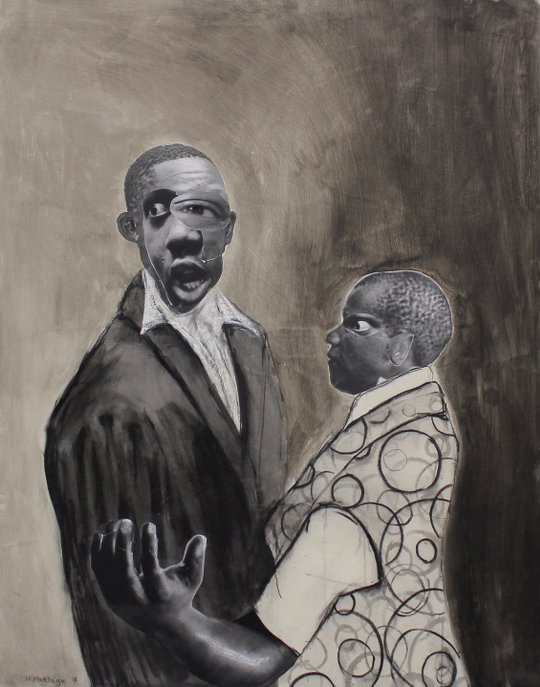Although the subject matter of Neo Matloga’s canvases is domestic – daily life in black households in the artist’s native South Africa – they often have the epic scale of 19th century history paintings. Like his use of a primarily black, white and grey palette, or the way he titles most of his works in his mother tongue, Sepedi, this decision is not without its political connotations or ambiguities. With their enamel tableware and crocheted tablecloths, his interiors are ordinary spaces, no more exotic than a suburban American home. However – to a global audience, at least – they are considerably less familiar than movies and TV. On these vast, charcoal and ink wash stages, Matloga’s cast of characters play out every-day dramas, depicting all the struggles and consolations of desire and intimacy. Above all the people in his canvases are, as he says, ‘moral agents’. Life outside (and, indeed, inside) the four walls of their homes is shaped by socio-economic and political conditions.
Notably, Matloga’s characters are hybrids, their faces formed by collaging together photographic images of friends, family and famous South African figures from politics and the arts. The physiognomy is often out of whack. Eyes, mouths and ears appear outsized, skin tones undergo abrupt changes, hairstyles and hats sit atop the wrong heads, and accessories such as jewellery and cigars are often comically misplaced. On one level we might interpret Matloga’s hybridisations as pointing to the vicissitudes of individual identity – the fact that the self is a kind of Frankenstein’s monster, in a state of permanent flux – but they also have a more poignant political purpose. Writing about his use of this technique in the series of works on paper, Black collages (2018), the artist has commented that ‘if there’s a possibility that a black face is seen as a distortion, what I’m saying is, OK, here, you have this image of distortion, which was already there in your prejudiced or racist gaze. The process of cutting, reconfiguring, and collaging facial anatomy is my way of trying to identify with the racist gaze, thereby dis-appropriating its oppressive power.’
In contrast to the characters that Matloga presents in his domestic canvases, all of whom inhabit the same physical space and all of whom (no matter how smooth or rough the current emotional weather) are bound by the ties of family and community, those that populate his Black collages are isolated against a white, featureless ground. Facing the viewer, their bodies cropped at the neck or chest, they look like images from a bureaucratic database, assembled to unknown ends. Presented en masse, these works have a curious, cumulative power. We begin to wonder what connects them, beyond the obvious answer embedded in the series’ title. Then we begin to wonder what keeps them apart.
Other participating artists: Anna Sophie de Vries, Benjamin Ramírez Pérez, Wouter Paijmans, Yana Naidenov, Sophie Lee, Johan Jensen Kjeldsen, Ricardo van Eyk, Vincent Ceraudo and Benedikte Bjerre
De Ateliers, Stadhouderskade 86 in Amsterdam. Opening hours 12 – 6 PM.


